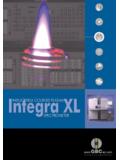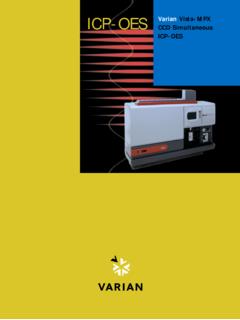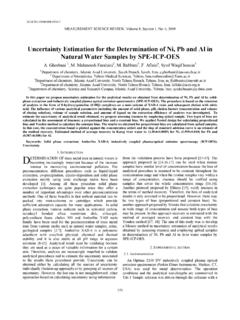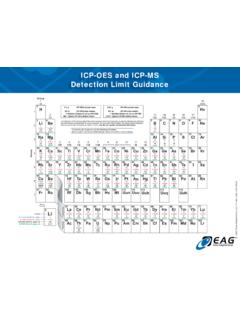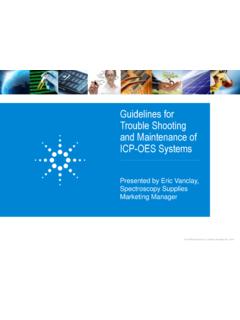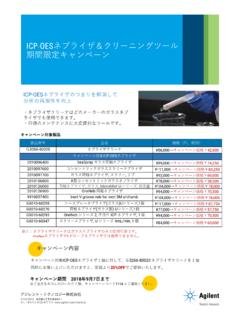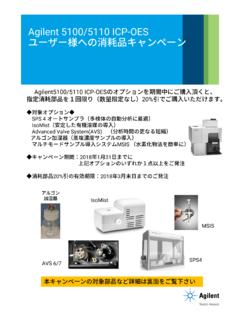Transcription of application note - GBC Scientific
1 AAS or ICP-OES Are They Competing Techniques?IntroductionThe analyst today is faced with a bewilderingchoice of techniques when deciding to enterthe field of elemental analysis. Should it beAtomic Absorption Spectrometry (AAS),Inductively Coupled Plasma Optical EmissionSpectrometry (ICP-OES), InductivelyCoupled Plasma Mass Spectrometry(ICP-MS) or Inductively Coupled Plasma ArcSpark (ICP-AS)?One of the areas where the choice issupposedly most difficult to resolve concernsAAS and ICP-OES. When ICP-OES wasdeveloped in the mid-1970 s, the scientificpress read ICP is going to sweep AAS awayand take over as the only analytical techniqueworth considering for liquid samples . Today,whilst there has been a significant move byanalysts away from AAS towards ICP-OES, itis important to remember that in fact thetechniques are complimentary rather and ICP-OES are solution-basedanalytical techniques, although solid samplinghas been pursued in both types of equipmentwith varying degrees of success.
2 Due tocommonality of sample type and samplepreparation, it is understandable that bothtechniques serve the same analytical following sample types can be analysedby either technique without the need for anymajor pre-treatments: Metals and alloys Ores, rocks and minerals Petroleum products Water and effluents Agricultural products Foods and beverages Horticultural research Environmental Clinical and pharmaceutical Cements, glasses and ceramicsIt is difficult, therefore, to differentiatebetween them on the basis of application area,although some applications are better suitedto one technique for particular reasons. Thosereasons are summarized aselement typeanddetection Type and DetectionLimitUsing these two criteria, it is possible tohighlight areas in which the techniques offerdifferent performance capabilities, thussimplifying the AAS first, particularly flameanalysis, the atom source is either anair/acetylene or a nitrous oxide/acetyleneflame.
3 This limits the excitation temperaturereached by the sample to 2600K for anair/acetylene flame and 3000K for a nitrousoxide/acetylene flame. The residence time ofan atom within the optical beam of thespectrometer, which determines theabsorption, is extremely short, approximately10-3seconds, depending on the velocity of theflame gases. For many elements this is not aproblem; compounds of the alkali metals,many of the heavy metals (lead, cadmium)and transition metals (manganese, nickel) areall atomized at high efficiency with eitherflame , there are a number of refractoryelements like vanadium, zirconium andmolybdenum which cause problems in flameAAS. The maximum temperature reached bythe nitrous oxide/acetylene flame isinsufficient to break down compounds ofthese elements and therefore sensitivity Scientific application notes ICP-OES1application noteWith an inductively-coupled plasma source,the sample experiences temperaturesestimated to be in the vicinity of results in atomization and excitation ofeven the most refractory elements with highefficiency so that detection limits for theseelements with ICP-OES can be well over anorder of magnitude better than thecorresponding values for flame atomicabsorption.
4 For approximately half of thetransition elements, the detection limits arewithin a factor of two for either flame AAS the other transition elements, the highertemperature of the plasma produces superiordetection limits. The lanthanides andphosphorus have significantly better detectionlimits for ICP-OES than flame AAS. Sulphurcan only be measured by ICP-OES. Acomparison of flame AAS detection limits inmg/L (ppm) with the corresponding ICP-OESdetection limits is shown in Table 1 for Table 1, many examples can be chosenwhich confirm the above statements whencomparing detection limits. For example,detection limits for cadmium, copper and zincare approximately the same by eithertechnique, but for sodium and potassium,detection limits are much better with flameAAS. However vanadium, zirconium andboron detection limits using ICP-OES arerespectively factors of 70, 500 and 500 betterthan the flame AAS detection an AAS is fitted with a graphitefurnace electrothermal atomizer thecomparison changes dramatically.
5 Althoughthe graphite furnace is restricted to a similarmaximum temperature to that of the nitrousoxide/acetylene flame, , 3300K, the atomresidence time is markedly greater (up to1000 ms) and this results in sensitivities up to100 times better than flame AAS values formany 2 lists GBC ICP-OES and graphitefurnace AAS detection limits in g/L. Thevalues indicate that the improvement inperformance of the graphite furnace accessoryagainst ICP-OES is similar to the ICP-OESimprovement over flame AAS. Thus mostelements including refractory elements likevanadium and molybdenum are betteranalysed by the graphite furnace , ICP-OES maintains ananalytical advantage when compared tographite furnace AAS for elements such asboron and the geological sciences, rare earthelements are now becoming more importantindustrially, but their analysis has been verydifficult because of their chemical is also a wide variation in theconcentration levels of individual rare earthelements in most geological materials.
6 Someof the light rare earths such as lanthanum,cerium and neodymium are present atrelatively high concentrations. Others may bepresent at levels 100 times lower, even in thesame sample. Normal geological practice is tonormalize sample results to the chondriticabundances ( , typical of levels found inchondritic meteorites, which are indicative ofthe element s cosmic abundance).Comparison of the flame AAS and ICP-OESdetection limits (Table 1) for rare earthelements indicates that flame AAS detectionlimits are unacceptable for analysis. Similarlygraphite furnace AAS (Table 2) shows poorsensitivity because of the very refractory,carbide-forming nature of the rare cannot be determined by AAS at a result, ICP-OES is the obvious choicefor solution-based analysis of these analysis of metals in biological samplesis another important requirement.
7 Table 3 listsreference range concentrations for severaltoxic metals in serum (or whole blood for leadand cadmium) and urine samples. All thevalues are quoted in g/L (ppb). Due to theviscous nature and high dissolved salts inthese fluids, they are normally analyzed aftera degree of dilution to reduce these of these reference range values(without dilution) with the ICP-OES detectionlimits given in Table 2 indicates thatICP-OES cannot analyze these samples. Forbiological analysis with these types ofsamples and concentration levels, graphitefurnace analysis is suitable. Therefore, as atechnique, graphite furnace AAS is theprimary method of analysis for body fluids aswell as biological tissue samples. Mostpublished methodology for biologicalmaterials involving ICP-OES is for tissueanalysis where analyte levels may beconcentrated during the sample dissolutionstage of two cases represent a situation wheredecision-making is reasonably clear cut.
8 Insome situations neither technique canadequately cover all eventualities, so that acombination of ICP-OES and AAS would bethe best or ICP-OES Are They Competing Techniques?2 GBC Scientific application notes ICP-OESWhen considering element type and detectionlimits, the following conclusions can some cases there are no significantdifferences between detection limits forflame AAS and ICP-OES. In general,differences of up to a factor of two tothree are not considered significant asthey are within the normal day-to-dayvariation in most more refractory the element, themore ICP-OES will be the favouredtechnique over flame furnace AAS will always holdan absolute performance advantage overICP-OES, except for the most refractoryand carbide-forming offers significantly bettersensitivity for the non-metal elementssuch as S, P and conclusions can be used by an analystwhen deciding which type of instrumenttechnique is suitable for their sample of AnalysisIn a number of analytical applications , forexample environmental analysis, speed can bean important factor.
9 Those advocatingsimultaneous ICP-OES regard it is the onlymethod worth considering for this taskbecause it is so much quicker in operation. Aninstrument which analyses samples in minutesis only fast enough if the sample preparationtime takes only a few each sample the analytical cycle consistsof an equilibration period (where the sampleis taken from the sample container into thespray chamber, then into the atomizer whereit reaches stability), a measurement period(during which the emission or absorptionsignal is measured at the element wavelength,and background correction performed),followed by the wash through (as the previoussample is being removed from the atomizerand spray chamber; this may be carried outconcurrently with equilibration by using thenext sample to wash through the previoussample). For AAS and sequential ICP-OESthe measurement period also incorporates aperiod of time as the next wavelength assess speed of analysis, assume therequirement is to analyse 10 elements persample.
10 Hence the techniques can be assessedin terms of the number of elementsdetermined per Simultaneous ICP-OES(a) A typical equilibration time for anICP-OES system employing a peristalticpump feed is relatively lengthy becauseof the low uptake rates ( mL/min) used for sampleintroduction. If the equilibration period isalso used for the wash-through phasethen a 25 second period may be required.(b) Measurement with a simultaneous systemdoes not involve any delays as thedifferent wavelengths have previouslybeen selected. Therefore only the actualmeasurement time is involved. Usuallythis is a total of 35 seconds for theintegration and the backgroundcorrection time period. This then gives acycle time per sample of 60 seconds anda resulting sampling rate of 60 samplesper hour. Therefore the system canmeasure at a rate of 600 elementdeterminations per Sequential ICP-OES Single and Dual Mono(a) Equilibration times for sequentialsystems are identical to those forsimultaneous systems, , 25 secondsoverall.
